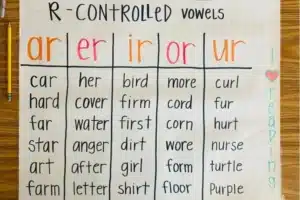
Source: istockphoto
The “ck Rule” is an important concept in English phonics, playing a vital role in understanding the details of spelling and pronunciation. This rule, while upfront, opens up a world of clarity for students dealing with the difficulties of the English language. It is particularly important for young readers and writers who are just starting to route the details of English spelling.
The “ck Rule” acts as a guiding inspiration, helping to clarify the often unclear phases of the English system. Its ease makes it a necessary tool in any language student’s toolkit, and knowing the “ck Rule” is a stepping stone to becoming capable in English spelling and pronunciation.
How Do You Teach The ck Sound?
Teaching the “ck” sound is a fundamental aspect of early literacy education. This sound, often represented by the “ck Rule” in phonics, is a key phonetic component that young learners encounter in numerous words. To properly gain knowledge of the “ck” sound, teachers and parents need to learn techniques that are pleasing, repetitive, and interactive. In this post, we will explore various techniques and tips on How Do You Teach The ck Sound, making sure that the concept is understood and gained by young students.
Understanding the “CK Rule”
Before going into teaching methods, it’s important to understand the “ck Rule” itself. The “ck Rule” says that the “ck” sound (as in “duck” or “sock”) is used at the end of a short vowel word. This rule is useful for the children to decode and spell words in the right manner.
Strategies to Teach the “ck” Sound:
Phonics Games and Activities
Interactive games are a fantastic way to teach the “ck” sound. Activities such as matching games, where children pair words that end in “ck” with corresponding pictures, enhance their understanding and recall.
Storytelling and Reading Aloud
Incorporate books that have a high frequency of “ck” words. Read aloud to the children, emphasizing the “ck” sound in words. This method not only teaches the sound but also fosters a love for reading.
Rhymes and Songs
Children remember concepts better when they are set to music or rhyme. Create or use existing songs and rhymes that focus on the “ck” sound. Singing these regularly will reinforce their learning.
Worksheets and Writing Exercises
Offers worksheets that give attention to “ck” words. Events could involve word searches, fill-in-the-blanks, or sentence formation. This not only teaches the “ck” sound but also improves writing skills.
Visual Aids and Flashcards
Visual stimuli aid memory. Use flashcards with “ck” words and corresponding images. Regularly review these with the children to reinforce the sound.
Pronunciation Practice
Regularly exercise the pronunciation of “ck” words. Inspire children to say the sound clearly, and correct softly if they make faults.
Use of Technology
There are numerous educational apps and online resources that focus on phonics, including the “ck” sound. These interactive tools can make learning more engaging for digital-native children.
Be a part of VES’s Phonics Teacher Training course by calling +919869866277 / +919869546913
To download the brochure, check here!

Source: pintrest
What is an Example of the ck Rule?
In the landscape of English spelling rules, the ‘ck Rule’ stands out as a simple yet essential guideline. This article aims to shed light on what the ‘ck Rule’ is and What is an Example of the ck Rule? As we explore this topic, keep in mind that the ‘ck Rule’ is a cornerstone in teaching spelling to beginners and plays a crucial role in understanding English orthography.
To further illustrate the ‘ck Rule’, let’s look at a few examples:
Duck
As mentioned earlier, ‘duck’ is a classic “Example of the ck Rule”. The short vowel sound in ‘u’ is followed by the /k/ sound, spelled as ‘ck’.
Back
Similarly, in ‘back’, the short vowel ‘a’ is followed by the /k/ sound, thus ‘ck’.
Trick
While ‘trick’ might seem an exception, it follows the ck Rule since the ‘i’ is a short vowel sound followed by the /k/ sound.

Source: owltutors
Rule for using ck at the End of a Word
The Rule for using ck at the End of a Word is a spelling rule that supports determining when to use ‘ck’ instead of just ‘k’ to represent the /k/ sound at the end of various words. This rule is mostly significant in monosyllabic words and is tough for proper spelling in English.
Key Aspects of the ‘ck Rule’:
After a Short Vowel
The primary aspect of the ck Rule is its application after a short vowel sound. When a single, short vowel is tailed by the /k/ sound, ‘ck’ is often used. For example, in words like ‘duck’ or ‘rock’, the short vowel sound previous to the /k/ sound requires the use of ‘ck’.
Exceptions: As with varied rules in English, there are exceptions. For example, words finish in ‘ic’ like ‘music’ or ‘picnic’ don’t tail this law.
Monosyllabic Words
The ck Rule is usually implied in words that contain one vowel. The use of ‘ck’ is uncommon in multisyllabic words.
Etymology
Occasionally, the spelling of a word is controlled by its origin. Words with different linguistic roots might not follow the standard ck Rule.
Be a part of VES’s Phonics Teacher Training course by calling +919869866277 / +919869546913
To download the brochure, check here!
What are the Exceptions to the ck Rule?
Despite its straightforwardness, the ‘ck Rule’ doesn’t always apply, and here’s where the exceptions come into play. Understanding the Exceptions to the ck Rule is essential for accurate spelling.
Let’s look at What are the Exceptions to the ck Rule?
Words finishing in ‘ic’
Various words in English end with ‘ic’ instead of ‘ick’. This is particularly common in adjectives and nouns taken from other languages. Examples include ‘public’, ‘magic’, and ‘picnic’.
Words with a Long Vowel Sound
When a word ends with a long vowel sound before the ‘k’ sound, we usually use just ‘k’ rather than ‘ck’. For example, ‘leak’, ‘speak’, and ‘streak’.
Words with a Silent ‘k’
Some words in English have a silent ‘k’ at the initial, making the ‘ck Rule’ irrelevant. For example ‘knee’, ‘knife’, and ‘knot’.
Greek Origin Words
English has many words derived from Greek that end with the ‘k’ sound but don’t follow the ‘ck Rule’. These often have ‘ch’ or just ‘k’ at the end. For example, ‘monarch’ and ‘music’.
Loanwords and Proper Nouns
The “ck Rule” is not followed by proper nouns and non-English origin words borrowed from other languages. For instance ‘Kafkaesque’ and ‘Yanukovych’.
Be a part of VES’s Phonics Teacher Training course by calling +919869866277 / +919869546913
To download the brochure, check here!

Source: steadfastacademy
How do you know when to Use ck or K?
The “ck Rule” is a guideline that helps determine when to use ck or k at the end of words. Understanding this rule is crucial for accurate spelling.
Here’s a breakdown of when to use ck or K:
After a Short Vowel
Use ‘ck’ after a short vowel sound. For example, in words like ‘duck’, ‘sock’, and ‘truck’, the vowel earlier ‘ck’ is small.
Example: In the word ‘kick’, the ‘i’ is a short vowel, hence the use of ‘ck’.
After a Long Vowel or Consonant
Use ‘k’ after a long vowel sound or consonant. Words like ‘speak’, ‘like’, and ‘bank’ follow this pattern.
Example: In ‘like’, the ‘i’ is a long vowel, making ‘k’ the correct choice.
Special Exceptions
English is known for its exceptions. Some words might not follow the standard “ck Rule”.
For example, ‘music’ and ‘monk’ are exceptions.
Applying the “ck Rule” in Everyday Writing
How do you know when to Use ck or K? It’s a question that often comes up in everyday writing.
Here are some directions to apply the “ck Rule” effectively:
Reading and Pronunciation
Pay attention to the vowel sounds in words. This will help you determine the length of the vowel and apply the rule correctly.
Practice with Word Lists
Create lists of words that use ‘ck’ and ‘k’. This will help reinforce the rule.
Is ck a Digraph?
In linguistics, the “ck Rule” refers to a specific spelling convention, but it’s important to understand Is ck a Digraph? To clarify this, “ck” is not a digraph. Unlike true digraphs, where two letters represent a single sound, in “ck,” both letters contribute to the pronunciation. This rule is often taught in English language education.
Join Vidhyanidhi’s course—where your journey in education truly transforms!
Be a part of VES’s Phonics Teacher Training course by calling +919869866277 / +919869546913
To download the brochure, check here!
FAQs
Where can I do Phonics Teacher Training?
Phonics Teacher Training is available at educational institutes like Vidhyanidhi Education Society (Govt. regd.), online platforms like Coursera, and specialized teaching centers.
How can I start Phonics Classes for Kids?
Start Phonics Classes for Kids by getting certified, preparing a curriculum, setting up a conducive learning space, and marketing your classes.
Which Institute offers Phonics Teacher Training Course Online?
Institutes like Vidhyanidhi Education Society offer Phonics Teacher Training Courses online.



